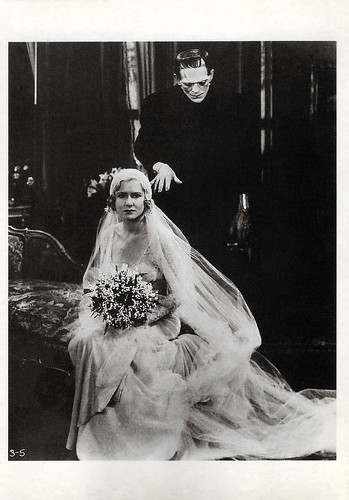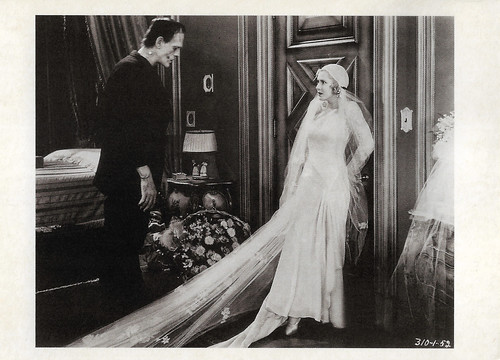
British postcard in the Picturegoer Series, London, no. 553a.

British postcard in the Film Partners Series, London, no. P. 11. Mae Clarke and Kent Douglass a.k.a. Douglass Montgomery in Waterloo Bridge (James Whale, 1931).

British postcard in the Film Weekly Series, London.
Hard luck roles
Mae Clarke was born Violet Mary Klotz in 1910 in Philadelphia, Pennsylvania, USA. She was exposed to cinema from an early age. Her father was an organist in a cinema. Growing up in Atlantic City, New Jersey, she learned how to dance. At the tender age of 13, she was already performing in nightclubs and amateur theatricals.
In 1924, she was one of ‘May Dawson's Dancing Girls’, a New York cabaret act. There producer Earl Lindsay discovered her. He promptly cast her in a minor part at the Strand Theatre on Times Square. She then performed as a dancer and burlesque artist at the Strand Roof nightclub, situated above the theatre which was managed by Lindsay and at the Everglades Club, earning $40 a week.
While there she struck up a lifelong friendship with fellow actress Ruby Stevens, who would later change her name to Barbara Stanwyck. In 1926, Clarke got her first chance in ‘legitimate’ theatre, appearing in the drama ‘The Noose’ with Stanwyck and Ed Wynn. This was followed by the musical comedy ‘Manhattan Mary’ (1927). In 1928, at age 17, she married her first husband, Lew Brice, brother of Fanny Brice. They divorced in 1930.
After further Vaudeville experience, Clarke was screen-tested by Fox and landed her first film role in the drama Big Time (Kenneth Hawks, 1929) opposite Lee Tracy. While she was top-billed in films like Nix on Dames (Donald Gallaher, 1929), she was headed for B-movie status and left Fox just over a year later. This resulted in better roles for her, though she was generally cast in ‘hard-luck’ roles.
1931 would be a banner year for Mae Clarke. She played prostitute Molly Malloy in the hugely successful The Front Page (Lewis Milestone, 1931) starring Adolphe Menjou and Pat O’Brien. On the strength of this performance, she was signed by Carl Laemmle Jr. at Universal. She starred in Waterloo Bridge (James Whale, 1931) as a young American dancer who is forced by circumstance into a life of prostitution in World War I London. Both the film and Clarke's performance were well-received by the critics. Reviewer Mordaunt Hall described Clarke's complex performance in The New York Times as "capital". Years later, the film sadly disappeared in the vaults of MGM when Vivien Leigh starred in the sanitized MGM remake, Waterloo Bridge (Mervyn Le Roy, 1940).

American postcard by American Postcard, no. 38. Boris Karloff and Mae Clarke in Frankenstein (James Whale, 1931).

American postcard by American Postcard, no. 37. Boris Karloff and Mae Clarke in Frankenstein (James Whale, 1931).
The monster in her bedroom
Mae Clarke was third-billed in James Whale's classic Horror film Frankenstein (1931). Mae played the role of Henry Frankenstein (Colin Clive)'s fiancée, Elizabeth, who was abducted by the Monster (Boris Karloff) on her wedding day. Her best moment in the film - one of sheer terror - comes when she is confronted by the Monster in her bedroom.
Also in 1931, she had the brief but iconic role for which she will always be known as the gangster’s girlfriend in The Public Enemy (William A. Wellman, 1931). James Cagney pushes a half grapefruit into Mae's face, then goes out to pick up Jean Harlow. She later appeared with Cagney (a close friend in real life) in still more adversarial scenes, in Lady Killer (Roy Del Ruth, 1933) and Great Guy (John G. Blystone, 1936).
She also had some feisty comedy roles in Three Wise Girls (William Beaudine, 1931) with Jean Harlow, and Parole Girl (Edward F. Cline, 1933). Sadly, Mae Clarke's career suffered several major setbacks, beginning in 1932, from which it never fully recovered. She had a nervous breakdown in June of that year and a horrifying stay at a mental institute for a few months. In March of 1933, she and actor Phillips Holmes were in a serious car accident that left Clarke with a broken jaw and facial scarring. In 1934, she had another nervous breakdown, most likely caused by overwork and marital problems. In addition to that, her sexy screen personae became restricted by the new, strict Hollywood Production Code.
When she returned to the screen it was to be in B-pictures. She had some rewarding parts in some films for Republic, notably The House of a Thousand Candles (Arthur Lubin, 1936) alongside Phillips Holmes, and the Civil War romance Hearts in Bondage (Lew Ayres, 1936), with Lew Ayres. Despite an image change from frizzy blonde to brunette, she had few opportunities to shine after 1938, except, perhaps, as the heroine of the Republic serial King of the Rocket Men (Fred C. Brannon, 1949). By the beginning of the 1950s, she was largely reduced to doing cameos and walk-on roles. At best, she played minor parts in Westerns and the classic melodrama Magnificent Obsession (Douglas Sirk, 1954) with Jane Wyman and Rock Hudson. She did make notable appearances on television, including General Hospital, Perry Mason and Batman. Her last film appearance was in Watermelon Man (Melvin Van Peebles, 1970).
Clarke fell on hard financial times towards the end of her life. In her 70s she worked in the ‘Court of Miracles’ show at the Universal Studios Tour in Hollywood. Clarke retired to the Motion Picture & Television Country House and Hospital in the Woodland Hills section of Los Angeles. She devoted her remaining years to her favourite hobby: painting in the style of Swiss abstract artist Paul Klee. Clarke was married and divorced three times: to Lew Brice, Stevens Bancroft, and Herbert Langdon. All of the unions ended in a divorce and were childless. Mae Clarke died in the Motion Picture & Television Hospital of cancer in 1992, aged 81. She is interred at Pierce Brothers Valhalla Memorial Park, North Hollywood, California. Very rye and very honest, Clarke gave lengthy interviews in her last years to biographer James Curtis that resulted in the autobiography ‘Featured Player' (1996), which came out shortly after her death.

British postcard in the Picturegoer Series, London, no. 553.

Italian postcard by B.F.F. Edit., no. 2638.
Sources: I.S. Mowis (IMDb), Danny (Pre-code.com), Find A Grave, Wikipedia (English and Dutch), and IMDb.
No comments:
Post a Comment